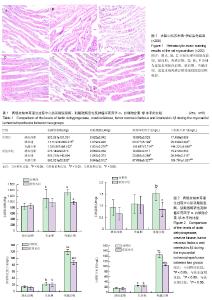| [15] Yang M,Chen J,Zhao J, et al. Etanercept Attenuates Myocardial Ischemia/Reperfusion Injury by Decreasing Inflammation and Oxidative Stress. Plos One.2014;9(9): e108024.[16] Kleinbongard P, Heusch G, Schulz R.TNFalpha in atherosclerosis,myocardial ischemia/reperfusion and heart failure. Pharmacol Ther. 2010;127(3):295-314.[17] Bian XY, Jiang BC. Protective effect of hydrogen-rich saline on liver ischemia-reperfusion injury in mice. Chinese Journal of Organ Transplantation.2011;32(3):177-181.[18] Gao C, Liu Y, Yu Q, et al. TNF-α antagonism ameliorates myocardial ischemia-reperfusion injury in mice by upregulating adiponectin.European Environment Agency. 2015;14(6):1551-1571.[19] 王艺璇,余志斌.TNF-α在心肌缺血再灌注重塑期的保护作用[J].心脏杂志,2014,26(3):357-365.[20] Kang MW,Song HJ,Kang SK,et al.Nafamostat mesilate inhibits TNF-α induced vascular endothelial cell dysfunction by inhibiting reactive oxygen species production. Korean J Physiol Pharmacol.2015;19(3): 229-234.[21] Sinha I, Giatsidis G, Orgill DP.Protective Effect of Hydrogen Gas Inhalation on Muscular Damageusing a Mouse Hind Limb Ischemia Reperfusion Injury Model. Plast Reconstr Surg. 2017;140(6):1207-1208.[22] He JB,Chen LL,Wang XY,et al.Dynamic changes of TNF-α in isolated rat heart at different time points after myocardial hypoxia/reoxygenation.Chin J Clin Th orac Cardiovasc Surg. 2015;22(12): 1147-1151.[23] 陈逸寒.氢气微泡减轻心肌缺血再灌注损伤的研究[D].南方医科大学,2015.[24] 何金波,包财盈,叶玉柱,等.缺氧/复氧大鼠心肌中IL-1β浓度的动态变化及意义[J].中国应用生理学杂志,2015,31(1):27-30.[25] Zhang Y, Sun Q, He B, et al. Anti-inflammatory effect of hydrogen-rich saline in a rat model of regional myocardial ischemia and reperfusion. Int J Cardiol.2011;148(1):91-95.[26] Hayashida K,Sano MI,Shinmura K,et al.Inhalation of hydrogen gas reduces infarct size in the rat model of myocardial ischemia-reperfusion injury. Biochem Biophys Res Commun.2008;373(1):30-35.[27] Sun Q,Kang Z,Cai J,et al. Hydrogen-rich saline protects myocardium against ischemia/reperfusion injury in rats. Exp Biol Med (Maywood). 2009;234(10):1212-1219.[28] 樊清波,赵江涛,简立国,等.饱和氢气生理盐水对大鼠心肌缺血再灌注损伤模型的影响[J].中华保健医学杂志, 2014,16(4): 296-298.[29] 李丽昕,傅国俊,孟晨阳.饱和氢盐水对大鼠心肌缺血再灌注损伤致炎性细胞因子的影响[J].基础医学与临床, 2013,33(4): 490-491.[30] 李波,吕国义,于泳浩,等.富氢生理盐水治疗相关疾病机制研究进展[J].天津医药,2016,44(2):250-252.[31] 孙立,谢克亮,马亚群,等.富氢盐水对缺血再灌注损伤保护作用的研究进展[J].现代生物医学进展,2014,14(13):2580-2582.[32] Ohta S.Molecular hydrogen as a preventive and therapeutic medical gas: initiation, development and potential of hydrogen medicine.Pharmacol Ther.2014;144(1):1-11. [33] George JF, Agarwal A.Hydrogen: another gas with therapeutic potential. Kidney International.2010;77(2):85-87.[34] Zhai X,Chen X,Ohta S,et al.Review and prospect of the biomedical effects of hydrogen.Med Gas Res.2014;4(1): 19-22.[35] Iuchi K, Imoto A, Kamimura N,et al. Molecular hydrogen regulates gene expression by modifying the free radical chain reaction-dependent generation of oxidized phospholipid mediators. Scientific Reports.2016;6(10):18971-18982.[36] Ayyadurai S, Gibson AJ, DCosta S, et al. Frontline Science: Corticotropin-releasing factor receptor subtype 1 is a critical modulator ofmast cell degranulation and stress-induced pathophysiology. J Leukoc Biol.2017;102(6):1299-1312. |

